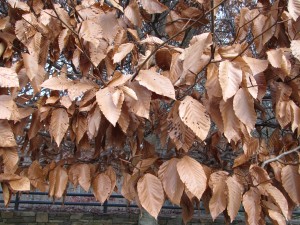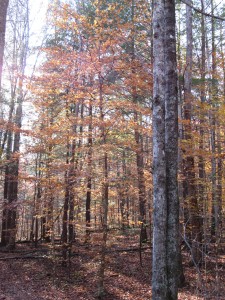Most deciduous landscape trees drop their leaves sometime in autumn. The physiology of autumn leaf drop is primarily stimulated by changes in photoperiod or shorter daylength. Autumn colors develop and the leaf petioles form an abscission layer. Black gum (Nyssa sylvatica), for example, start to color up in early September.
Winter leaf retention by deciduous trees is termed “marcescence”. Some hardwood trees, particularly Beech (Fagus spp.) and oak (Quercus spp.) trees, retain their leaves through the winter months in Northeastern U.S. Oaks and beeches are in the Fagaceae family. Additional species include witch hazel (Hamamelis spp.), hornbeam (Carpinus spp.), and hophornbeam (Ostrya virginina).
Most (not all) oaks and beeches begin shedding old leaves the latter days of February. Plant scientists speculate that retained leaves may deter browsing animals such as deer. The dried leaves may help to protect dormant buds or make them difficult to nibble on. Dried leaves are likely less nutritious.
Most years Japanese maple (Acer palmatum) have shed their leaves by late November. Some cultivars may be slow to shed their foliage, and are caught in an early hard frost. Leaves turn brown and hang on for several weeks, sometimes for months. Dissected leaf varieties are more affected compared to palmate types. Fine textured dissected-leaf cultivars, like ‘Tamukeyama’ and ‘Waterfall’, often retain their brown withered foliage until early March.
Young and newly planted landscape trees tend to retain leaves their first year after planting. Fruit trees, specifically apple and pear trees, are in a juvenile stage.
But not to worry. High winds, snow loads, and rains in winter, in addition to swelling of vegetative buds in the spring causes marcescent leaves to fall to the ground.



 Posted in
Posted in 
